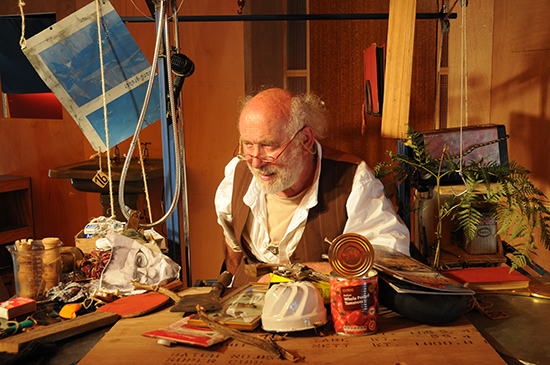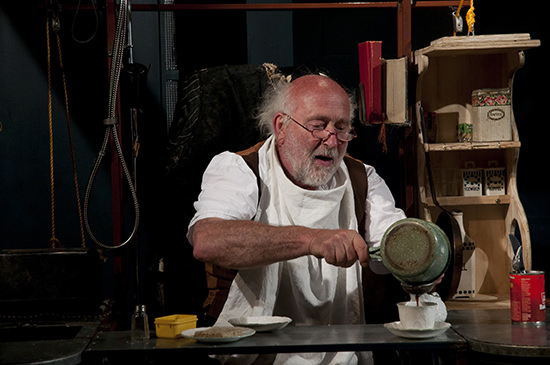Embracing a new reality
Zsuzsanna Soboslay, Justus Neumann, Alzheimer Symphony

Justus Neumann, Alzheimer Symphony
photo Wolfgang Kalal
Justus Neumann, Alzheimer Symphony
“Who is it that can tell me who I am?” The Tragedy of King Lear, Act I, iv
“Amidst his daily routines, a famous actor tries to recall the lines to Shakespeare’s King Lear, but they are starting to escape him. He develops tricks to fight his forgetfulness as it follows him into every corner of his private life. He forgets the name of his sons, cannot recognise a picture of his mother, and when he finds a sock in his soup he eats it without questioning. As his memory increasingly eludes him, he obstinately fights with all his might but is gradually left with no choice but to embrace his new reality. Important things become unimportant, feelings become stronger than thoughts and his inner child is revived” [program note].
So there you have it, reader: the full story of what Alzheimer Symphony is ‘about.’ I probably can’t do better than this.
Except, I can report that I cried for the whole 70 minutes of it. I can report that what I saw was a work by a former denizen of the Austrian Schauspielhaus who now lives and devises in Tasmania and performs mostly in Europe. That this is the work of a man who does not perform much in his adopted homeland, but has initiated a business teaching others confidence and presentation skills (not theatre), because theatre translates into life in this way. Art is life is love is life is art. Is this why I am crying?
This one-man show cuts to the heart of what we fear as we emigrate from one part of our lives to another. For what is the value of a man, when his mind slips, his memory sags, his world becomes a delimiting cage?
Justus Neumann’s demented actor now lives in one cubic metre squared. The cube—his house, his stage, throne and prison–both restricts and enables a little life around him. Within that fantastical square, he conducts his ablutions, cooks his toast and eggs and recites. But then the phone rings. He has forgotten something. What is it? He receives an instruction, something logical, simple, everyday.
The protagonist of Alzheimer Symphony is both King Lear, mad on the moors, and Vladimir [or is that Estragon?] from Waiting for Godot, but he is also, brilliantly and painfully, Neumann himself contemplating inevitable decline, as we do ours—every one of us—in watching. Neumann’s eyes are both haunted and eager, looking to the past he can’t quite remember and to the future he still hopes for.
Waiting for Godot is a play of containment in time, where ‘nothing happens’ and ‘nobody comes.’ The characters are mad enough to stay, but not maddened enough to leave. In truth, what choice have they?—that terrifying question, forever lurking from just off-stage. Maybe there is nowhere else to go: in the midst of the great architecture of their world, little progresses and nothing arrives. There is perhaps nothing else.

Justus Neumann, Alzheimer Symphony
photo Wolfgang Kalal
Justus Neumann, Alzheimer Symphony
Lear, however, is a personage who can make things appear and disappear at will—divide land, execute bodies, drown kingdoms. Nonetheless, Shakespeare’s tragedy shows greatness losing the architecture that supports a great man’s power. On the wind-blown heath, Lear loses his mind.
Neumann’s “Blow, winds, and crack your cheeks” is electrifying, despite the residual smell of toast and eggs, and the grasping for mnemonic objects such as a hairdryer and balloons to represent ‘wind’ and ‘cheeks’ respectively. He crows, “I can do it; I can still do it,” with desperate bravado.
But as the piece progresses, mnemonics fail. This Lear is left with the objects themselves, synecdoches of their own plastic worlds and nothing more. Yet, named and celebrated, they become a concrete poem of spatulae, eggs, ballons and photographs, which constitute an alternative virtuosity. The sweet beauty here is that Neumann takes pleasure in the forgetting, in constructing a narrative that falls apart in order to restructure, that reminds us that we are homo ludens—creatures that play. As we begin, speaking in the tongues of babes, so perhaps do we end.
The work’s title refers to Schubert’s Unfinished Symphony, excerpts of which we hear throughout the show. Musicologists disagree as to whether Schubert failed to complete a great work or whether it is ‘perfect’ outside of expectations of classical form. The tension between ‘Here am I’ and ‘Where have I now wandered to’ is central to the greatest of all performances. In Neuman’s small and brilliant work, ‘imperfection’ resounds as tribute to the beauties which stab at the heart even when we cannot contain them in what we expect and already know.
A post-show forum with members from Alzheimer’s Australia generated a moving discussion on the effects of dementia on sufferers and their families. Members of the discussion panel—including doctors and spouses—spoke of the liberations that come from accepting one’s condition. The great challenge to our society, and how we identify ourselves within it, is not just about what we know and remember, but what is valued.
Justus Neumann’s work is vigorous, subversive and tragically funny. Even while watching it, I knew I would never forget its impact on my body and mind. I stand on the heath of my own ageing vulnerability, feeling and watching.
You can see excerpts from Alzheimer Symphony here and an interview with the artist here.
The Street Theatres’ Segue festival: Alzheimer Symphony, performer, co-writer Justus Neumann, co-writer Hans Peter Horner, director Hans Peter Horner, designer Greg Methe, original music Julius Schwing; Street Theatre, Canberra, 5-8 May
RealTime issue #133 June-July 2016






